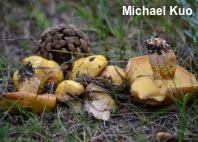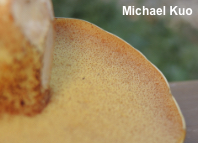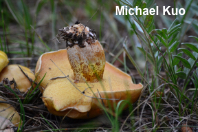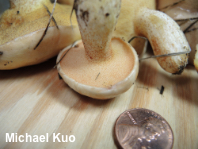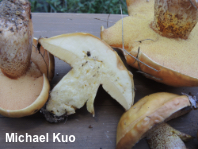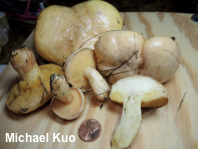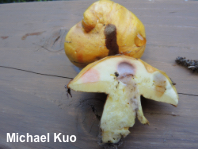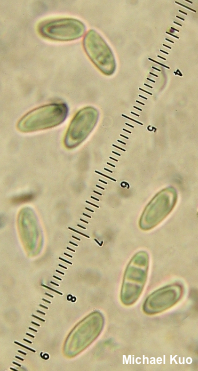| Major Groups > Boletes > Suillus > Suillus wasatchicus |

|
Suillus wasatchicus [ Basidiomycota > Boletales > Suillaceae > Suillus . . . ] by Michael Kuo Suillus wasatchicus is a poorly-known, rarely documented mycorrhizal associate of ponderosa pine in the southern Rocky Mountains—one of several North American species that have been previously identified with the name of the European species Suillus granulatus. If I am interpreting the species correctly, it is best identified by its young pore surface, which is pale orange and covered with abundant glandular dots. Suillus kaibabensis, also an associate of ponderosa pine, is very similar, but features a pale yellow to whitish young pore surface with scattered or absent glandular dots; additionally, its cap turns dark gray with KOH, whereas the cap of Suillus wasatchicus turns purple. There may also be a slight difference in spore sizes, with the spores of Suillus wasatchicus averaging a bit shorter. For those who care about such things, interpreting Suillus wasatchicus based on the protologue (Thiers 1976) and subsequent literature is a bit of a nightmare, since the author of the species, Harry Thiers, either changed his mind about the species or made typographical errors in his second account (1979). Originally, Thiers said "[t]he reddish to pink discoloration of the pores of S. wasatchicus due to the accumulation of glandulae is highly distinctive," while the pore surface of Suillus kaibabensis was yellow "or frequently dark salmon." However, in the 1979 publication Thiers calls the pores of Suillus kaibabensis "pink to reddish (due to abundance of glandulae)"—exactly what he previously said distinguished Suillus wasatchicus—and mentions nothing about the pore surface of Suillus wasatchicus being distinctive, opting instead to key the species as distinct by virtue of it having a "[p]ileus yellow at maturity," while other species in the group have a "[p]ileus colored buff, brown or ochraceus at maturity." This is in conflict with the 1976 description of Suillus kaibabensis, which allows the cap to be "sometimes more yellow" than its usual "buff to light brown" color. Aaaand, further complicating interpretation, Thiers still recognized a southwestern "Suillus granulatus" in the 1979 publication, associated with However one interprets the two species, they are indeed phylogenetically distinct—and not particularly closely related; Nguyen and collaborators (2016) included ITS sequences from the type collections of both species, finding that Suillus kaibabensis is within striking distance of Suillus granulatus but that Suillus wasatchicus is located rather far away, in a group containing Suillus albivelatus, Suillus pseudoalbivelatus, and Suillus volcanalis. Description: Ecology: Mycorrhizal with ponderosa pine; growing scattered or gregariously in monsoon season (late July through early September); originally described from Utah; widespread in the southern Rocky Mountains. The illustrated and described collections are from Colorado. Cap: 3–10 cm; convex becoming broadly convex; sticky when fresh; bald; bright golden yellow to dull yellowish or nearly whitish; the margin often featuring a thin, whitish, sterile zone, especially in young specimens. Pore Surface: Pale orange when young, becoming orangish yellow and eventually brownish yellow; with abundant orangish to pinkish or cinnamon glandular dots throughout development; 2–3 angular pores per mm; tubes to 8 mm deep. Stem: 3–5 cm long; 1.5–3 cm thick; stout; more or less equal; dry; yellowish to bright yellow at the apex, whitish to brownish below; with conspicuous, cinnamon glandular dots that frequently become large and elongated with maturity, resulting in smears and lines; without a ring. Flesh: Whitish in cap; pale yellow in stem; not staining on exposure. Odor and Taste: Not distinctive. Chemical Reactions: Ammonia pink on cap surface; pink on flesh. KOH dark purple on cap surface; purple on flesh. Iron salts negative on cap surface; blue on flesh. Spore Print: Cinnamon brown. Microscopic Features: Spores 6–9 x 3–3.5 µm; boletoid-fusiform; smooth; hyaline in KOH; inamyloid. Basidia 18–25 x 3–5 µm; subclavate; 4-sterigmate. Cystidia in gelatinized, brown bundles; often poorly defined individually; 40–90 x 6–8 µm; clavate, subfusiform, or subcylindric; smooth; thin-walled; brown in KOH. Pileipellis an ixocutis; elements 2.5–5 µm wide, smooth or a little encrusted, hyaline in KOH. REFERENCES: H. D. Thiers, 1976. (Thiers, 1976; Thiers, 1979; Both, 1993; Bessette, Roody & Bessette, 2000; Klofac, 2013; Nguyen et al., 2016.) Herb. Kuo 08021701, 08031701. This site contains no information about the edibility or toxicity of mushrooms. |
© MushroomExpert.Com |
|
Cite this page as: Kuo, M. (2022, March). Suillus wasatchicus. Retrieved from the MushroomExpert.Com Web site: http://www.mushroomexpert.com/suillus_wasatchicus.html |
